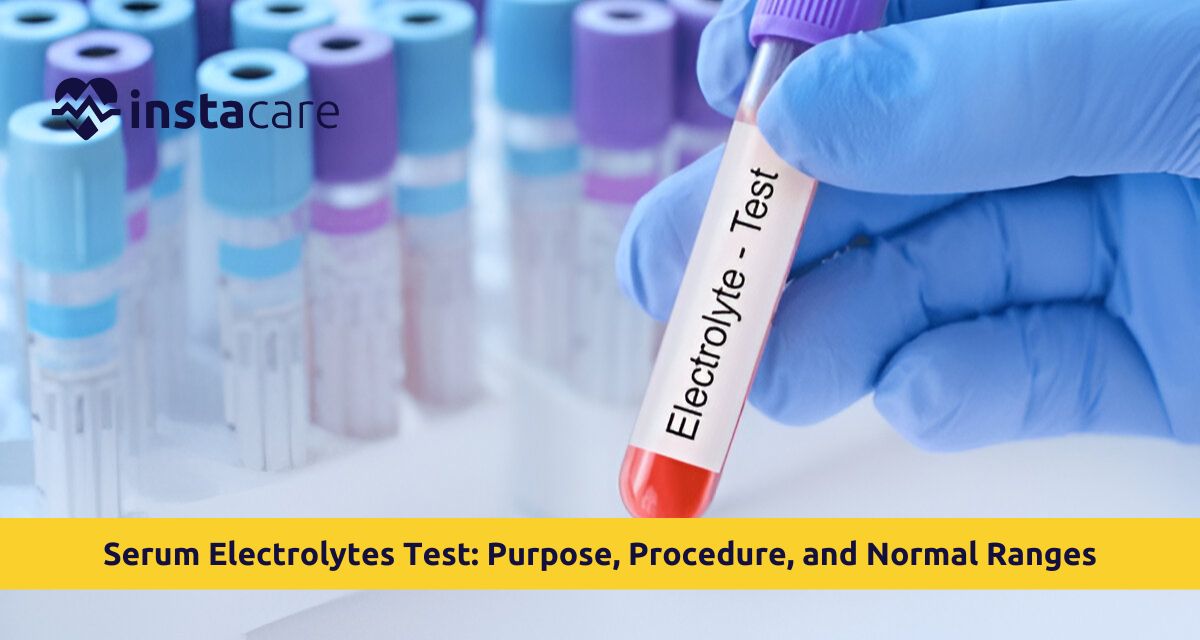Serum electrolytes test is a routine blood test that is used to measure the level of necessary minerals such as sodium, potassium, chloride, and bicarbonate. They are absolutely essential chemicals to sustain fluid balance in the body, muscle contraction, nerve impulse, and conduction. The test is utilized for the diagnosis of electrolyte imbalance, checking the treatment of long-term diseases, and the diagnosis of dehydration or organ failure. Whether you’re managing ongoing health conditions or facing symptoms like fatigue or irregular heartbeat, monitoring your blood electrolyte levels can provide valuable clinical insight.
What is a Serum Electrolytes Test?
A test for serum electrolytes, or an electrolyte panel, is a blood test to measure the amount of electrolytes in the blood. They are sodium (Na⁺), potassium (K⁺), chloride (Cl⁻), and bicarbonate (HCO₃⁻).
They are used for several reasons:
- Serum sodium test is to evaluate fluid status as well as nerve function.
- Serum potassium test is to have a low concentration of potassium or an excess, which influences heart as well as muscle function.
- Serum chloride test assist in the acid-base balance.
- Evening serum bicarbonate test assist in the identification of the function of the kidney and lung to establish its body pH into equilibrium.
All these above tests combined assist in kidney disease, metabolic disease, or electrolyte deficiency diagnosis.
Why Is the Serum Electrolytes Test Done?
Doctors are prescribing the Sodium potassium chloride test in some medical illnesses. The most frequent illnesses where the test needs to be prescribed are:
- Dehydration and electrolyte test: To measure whether water loss (secondary to vomiting, diarrhea, or heat) altered mineral content.
- Kidney or heart disease: To closely monitor such complications as demonstration of increased sodium or potassium depletion.
- Hypertension and diuretic therapy: To check for change in sodium and potassium.
- Untreated weakness, fatigue, or confusion: Which may be secondary to electrolyte imbalance.
- Diabetes or endocrine disease: As they tend to alter blood electrolytes.
Uses of serum electrolyte test therefore include diagnosis and treatment of numerous acute and chronic disease.
How to prepare for a Serum Electrolytes Test?
Preparation for serum electrolyte test is not much. It does not necessarily involve fasting unless specified along with other blood tests.
A few tips are as follows:
- Medications: Inform your doctor if you’re taking diuretics, blood pressure medications, steroids, or antacids, as these can affect blood electrolyte levels.
- Dietary intake: Your doctor might suggest avoiding eating salty or potassium-rich foods before the test.
- What to wear: Wear something that has access to your arm so that it can be easily done to draw the blood because in most cases, the blood is drawn from an elbow crease vein.
There are no precautions required in most cases, but good advice from your doctor gives good outcomes.
Serum Electrolyte Test Preparation
Procedure for Serum Electrolyte Test:
- Procedure is painless and quick.
- It's the taking of a blood sample from a vein.
Step-by-step procedure:
- A band is placed around your upper arm to make the veins stand out with blood.
- Alcohol is applied to your skin.
- The needle is placed in the vein so the blood will be drawn into a tube.
- The sample is labeled and sent to the lab.
- The test will only take 5-10 minutes.
- Electrolyte imbalance test is not painful for most patients, bruising or mild pain at the puncture area a risk.
- You can go back to your normal activity after sample collection. Recovery time is none.
Follow-up post-test:
- Bruising or tenderness might be experienced at the puncture area.
- Resume water intake and regular diet unless otherwise directed by your physician.
- Your doctor will contact you with test results in one or two days.
Special precautions are not required unless you are being treated for an underlying predisposing electrolyte abnormality. Your doctor may re-order the test or adjust medication in the case of an abnormal result.
Interpreting the Results of a Serum Electrolyte Test
Your doctor will compare test values with the Electrolyte test normal range, which may vary slightly from lab to lab.
Normal values in most cases:
- Sodium: 135–145 mEq/L
- Potassium: 3.5–5.0 mEq/L
- Chloride: 98–106 mEq/L
- Bicarbonate: 22–30 mEq/L
Inappropriately Low potassium levels may result from vomiting, diarrhea, or diuretics. High sodium symptoms are thirst, confusion, or restlessness, usually dehydration.
Lower or higher than the normal range for any of these values may signify:
- Kidney disease
- Heart disease
- Metabolic acidosis or alkalosis
- Hormonal imbalance
Your doctor may order repeated tests or have a specialist conduct additional tests.
Diseases Detected by Serum Electrolytes Test
Serum electrolytes test is not only employed for screening dehydration, it uncovers potentially lethal medical disease, including:
- Kidney disease: Acute and chronic, especially with hyperkalemia or abnormal bicarbonate.
- Cardiac disorders: Cardiac rhythm is derived from electrolytes.
- Endocrine disorders: Including Addison's or Cushing's disease.
- Respiratory acidosis/alkalosis: By serum bicarbonate test.
- Diagnosis of electrolyte depletion: Particularly in malnutrition or gastroenterological ill patients.
If drowsy, rapid heart, or disoriented, your physician can add this test to an expanded workup.
Serum Electrolyte Test vs Creatinine Test
Serum electrolyte test and creatinine test are usually prescribed jointly, particularly with kidney function panels.
Important differences:
- Role of serum electrolyte test is on monitoring minerals (sodium, potassium, chloride, bicarbonate) in blood.
- Creatinine test is measuring an end product of waste that is removed by kidneys and assists in approximating the filtering ability of the kidney.
- Imbalances are indicated on the panel of electrolytes, but that is the test on how efficient your kidneys are working, the test for creatinine suggests.
Both yield a clearer picture of metabolic as well as renal function.
Serum Electrolyte Test Price in Pakistan
The
cost serum electrolyte test would differently from city to city and even lab to lab. It would cost between PKR 800 to PKR 2,000 for average.
Kidney function test or creatinine can be added on as a package at additional cost. Govt hospitals would get it done at subsidized rates and private labs would get it done with the quick report for some additional money. Always make sure to get it done in a lab that is certified to obtain proper and timely results.
Book lab tests from the
best-certified labs in Lahore, Karachi, Islamabad, and all major cities of Pakistan through
InstaCare, and get a discount of up to 35%. For assistance, call our helpline at 03171777509 to find the right lab test for your health needs.

